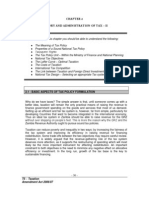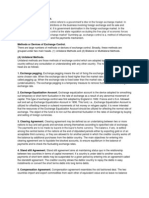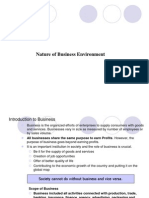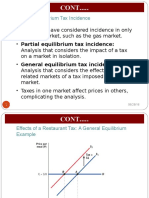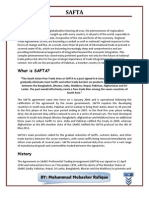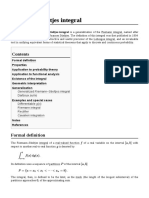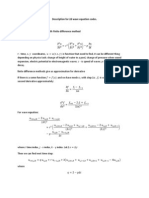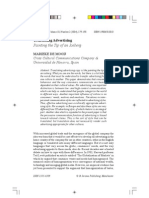Professional Documents
Culture Documents
SAFTA
SAFTA
Uploaded by
crabrajesh007Original Description:
Copyright
Available Formats
Share this document
Did you find this document useful?
Is this content inappropriate?
Report this DocumentCopyright:
Available Formats
SAFTA
SAFTA
Uploaded by
crabrajesh007Copyright:
Available Formats
Introduction of SAFTA SAPTA was envisaged primarily as the first step towards the transition to a South Asian Free
Trade Area (SAFTA) leading subsequently towards a Customs Union, Common Market and Economic Union. In 1995, the Sixteenth session of the Council of Ministers (New Delhi, 18-19 December 1995) agreed on the need to strive for the realization of SAFTA and to this end an Inter-Governmental Expert Group (IGEG) was set up in 1996 to identify the necessary steps for progressing to a free trade area. The Tenth SAARC Summit (Colombo, 29-31 July 1998) decided to set up a Committee of Experts (COE) to draft a comprehensive treaty framework for creating a free trade area within the region, taking into consideration the asymmetries in development within the region and bearing in mind the need to fix realistic and achievable targets. The Agreement coming into force the SAFTA Ministerial Council (SMC) has been established comprising the Commerce Ministers of the Member States. To assist the SMC, a SAFTA Committee of Experts (SCOE) has been formed. SCOE is expected to submit its report to SMC every six months. The SAFTA Agreement states that the the SMC shall meet at least once every year or more often as and when considered necessary by the Contracting States. Each Contracting State shall chair the SMC for a period of one year on rotational basis in alphabetical order. The Meetings of SMC and SCOE held so far are:
HISTORY of SAFTA The South Asian Free Trade Agreement (SAFTA) signed by the members of the SAARC and implemented in July 2006, has since been a matter of concern for the countries involved, regarding how effective it is in increasing the economic wellbeing of the region in general. When it was initially signed, the goals included forming a common currency for the region and forming a Customs Union (CU) which would eventually lead to Total Economic Integration. The first stage of the agreement has been successful for only certain countries, and Sri Lanka only to some extent. Recently a survey was conducted on the quantification of the benefits of the SAFTA to the region as a whole was undertaken by The ADB and the United Nations Conference on Trade and Development (UNCTAD). The findings were discussed at a forum hosted by the Institute for Policy Studies, with the hope that some of the feedback could be included in the results, which in turn could be presented to the member governments to better their trade policies. 1
At the 14th SAARC Summit, the Prime Minister of India stated that as the largest country in the region, India was ready to accept asymmetrical responsibilities including opening her markets to her South Asian neighbors without insisting on reciprocity. He also announced that before the end of the current year, India would allow the LDCs among its South Asian neighbors duty free access to its markets (in SAFTA Agreement the commitment is for bringing the duties to 05 percent). It will also further reduce the sensitive list in respect of these countries. As per this announcement, India would reduce tariffs to zero (duty-free) for the LDC members by December 31, 2007 whereas as per the SAFTA tariff liberalization programmer, the reduction to 05 percent for the LDCs was to be completed by December 31, 2008. India has since eliminated tariffs for the LDC members by advancing the tariff liberalization programmer through suitable Custom Notifications (Notification India is also in the process of reducing its Sensitive List for LDCs. Bangladesh and Maldives would be the major beneficiary of this move to get duty free access to the Indian market.
Objective of SAFTA The objectives of the SAFTA are to promote and enhance mutual trade and economic co-operation among the SAARC countries: Promoting conditions of fair competition in the free trade area and ensuring equitable benefits to all contracting states, taking into account their respective levels and pattern of economic development; Eliminating barriers to trade and facilitating the cross-borders movement of goods between the territories of the contracting states; Creating an effective mechanism for the implementation and application of this agreement, for its joint administration and for the resolution of disputes; Establishing a framework for further regional co-operation to expand and enhance the mutual benefits of this agreement.
Principles of SAFTA SAFTA shall be governed in accordance with the following principles: The contracting state affirms their existing rights and obligations with respect to each other under Marrakech Agreement Establishing the World Trade Organization and other treaties/agreements to which such contracting states are signatories; SAFTA will be governed by the provisions of this Agreement and also by the rules, regulations, decisions, understanding and protocols to be agreed upon within its framework by the contracting state; SAFTA shall be based and applied on the principles of overall reciprocity and mutuality of advantage in such a way as to benefit equitably all contracting states; SAFTA shall involve the free movement of goods between countries through inter alia, the elimination of tariffs and non-tariff restrictions on the movement of goods and any other equivalent measures; SAFTA shall entail adoption of trade facilitation and other measures and the progressive harmonization of legislations by the contracting states in the relevant areas; and The special needs of the least developed contracting States shall be clearly recognized by adopting concrete preferential measures in their favor on a non-reciprocal basis.
SAFTA has created some concerns like Tariff compensation for LDCs which may remain a sticking point. High value goods in negative lists could dilute benefits. Product specific deviations for agreed ROO (rules of origin) may lead to inflow from third countries. It will take some time to resolve complex issues relating to tariff compensation mechanisms like negative lists of products to be kept outside the agreement. Inter regional trade in South Asia has shown weak performance at 5 percent compared to 35 percent in ASEAN, 55 percent in NAFTA and 62 percent in the EU. This has partly been due to the political standoff between the two largest economics of the region, India and Pakistan. The South Asian Free Trade Area (SAFTA) replaces the earlier South Asia Preferential Trade Agreement (SAPTA) and may eventually lead to a full-fledged South Asia Economic Union.
Benefits of SAFTA
The United States joins the world in congratulating the signatories of the South Asia Free Trade Agreement, an achievement that promises to have a positive impact on economic growth and development in the region. The recent negotiations bodes well for the tough work that still lies ahead to successfully implement the framework. The US is optimistic that the nations of South Asia will exhibit the same spirit of cooperation that led to the signing of this important endeavor in 2004. The potential benefits of SAFTA-type arrangements in the region are significant. Regional trade in South Asia now accounts for less than 6 per cent of total trade, compared to 22 per cent within the Asean Free Trade Area, and 65 per cent within the EU. Free trade fuels economic growth. Free trade fuels investment, creates jobs, and raises incomes. Free trade lifts people out of poverty. This is not mere ideology. Recent World Bank studies show that developing countries that have embraced open-market strategies in the past decade have grown much faster than those that have not. As President Bush said at the signing of the US-Australia Free Trade Agreement, "One of the great economic achievements since the end of the Cold War has been the success of free and fair trade in raising up the world's poor, bringing hope to the world's hopeless, promoting freedom among the world's oppressed, and creating jobs at home and abroad." In fact, freer trade brings increased prosperity for all countries -- developed and developing, large and small. Trade and economic growth reinforce each other. In the US, for instance, as total trade as a share of the US economy has risen from 10 per cent to nearly 30 per cent, the economy itself has grown from about $1.6 trillion to over $11.7 trillion. That growth is expected to continue as tariffs are lowered on more categories each year. Exports under this agreement already make up 16 per cent of Jordan's exports to the US and will continue to do so. The numbers speak for themselves. Governments linked by trade and investment are working more closely and accomplishing more than ever before on issues that affect the daily lives of their citizens. The US shares the awareness and concerns of the nations of South Asia that some of the opportunity and prosperity brought by freer trade can pose challenges for some producers. It is important to minimize these short-term disruptions and build capacity for a broad range of citizens to benefit from trade's increased opportunities. The experiences of rapidly-growing developing countries, such as those in South Asia, demonstrate that continued protectionism only perpetuates inefficiencies and stagnation. Freer trade, by contrast, rewards ambitions across the board. The challenge lies in finding ways to use the new resources derived from trade to expand opportunity -that is, in improving government so that an entire economy, not just individuals and businesses, becomes more competitive. Just as the Asian Free Trade Agreement resulted in both greater intra-regional trade and greater foreign investment among South-East Asian nations, so too will be the benefits of SAFTA. The Indo-Sri Lankan Free Trade Agreement, one of the first bilateral agreements within South Asia, is a vivid illustration of two countries working together to overcome these challenges. The agreement has
already brought economic benefits to both countries, contributed to greater cooperation, and created a sense of shared fortunes. The SAFTA framework agreement carries the great promise of sustainable regional economic growth and development. It also promises to add momentum to the Doha development global trade negotiations, which the World Bank estimates can lift more than 300 million people out of poverty.
Impact of SAFTA on Indian Economy The world we live in today has largely become something of a global village where happenings in one part of the world affect the other parts as well. All nations are interdependent and all the countries tend to compete with one another. In such a scenario a nation with economic clout is able to forge its existence and do well for its people. Economic clout as such can be developed through efficient allocation of resources which therefore results in trade being given considerable importance. Adam smith in his book Enquiry into the nature and causes of the wealth of the nations talks of the benefits of trade where he says that trade creates an outlet for surplus produce for which there is no demand in the home country and which brings back in return for it something else for which there is a demand. Furthermore, trade provides a wider market, it increases foreign investments, helps in getting new resources from trade which expands opportunities and increases competition, it creates jobs, helps in movement of technology and skilled labour, raises the national income, expedites growth and hence in totality helps to increase the standard of living and decrease poverty. Further it results in deepening social and cultural ties resulting in better mutual appreciation, international understanding and sustained peace. The concept of RTA promoting free trade areas arise from the need to promote intra-regional trade for economic prosperity. The RTA first took shape in the 1980s and the 1990s when the multilateral framework of WTOs Uruguay round was faltering and the negotiations were at a point of no resolve when the leaders thought of this alternate option where there were to be economic blocks between whom there would be liberalised trade, preferably free trade with relaxation to tariffs and trade/non-trade barriers (like quality standards, sanitary measures, licensing, technological specifications etc) with direct trade rather than importing to or exporting from a third country which saves on the freight cost, helps in optimally using the resources and so expands mutual trade benefiting all. As of today 120 countries of the world which form almost 85% of the world trade are members of regional trading groups with exactly 76 such groupings being recorded by the WTO. Some of such successful trading groups are NAFTA in North America, APEC of Latin America, European Union, and ASEAN of south-east Asia and SAARC or South Asian Association of Regional Cooperation. The last one being of interest, it being responsible for implementation of SAFTA.
The idea of SAARC was first mooted by the former Bangladesh president Zia-ur-Rehman with the objective of forming an association on the lines of the ASEAN to promote the welfare of the people of south Asia and accelerate economic growth in the region. Hence, on 7-8 Dec 1985 in Dhaka , a formal charter was signed by the seven founder members Bhutan , Bangladesh, Nepal, India , Sri lanka, Pakistan and the Maldives(Afghanistan is the most recent member.) But, there were road-blocks to the implementation of free trade and the regional trade of South Asia remained at 4% compared to 22% of ASEAN and 85% of EU since 1995, though from the inception of SAARC the trade has increased from 3.5% in 1970 to 2.4%in 1990 to the present 4.1%. The imports from Bangladesh, Nepal and Sri Lanka to India seem to be increasing over the years and even trade has increased from 8% in 1980s to 19.4% in 2003 but only marginal increase has been there in case of Pakistan i.e. from 1.6 % to 2.4%. Thus, a framework for gradual liberalisation namely the SAPTA (South Asian Preferential trade agreement) was envisaged with the objective to intensify trade ties giving concessional tariffs and favourable treatment to least developed nations. This was signed in Dhaka on the 11th of April 1993. This tariff liberalisation would not be applicable to the tariff lines included in the Sensitive Lists to be incorporated in this Agreement as an integral part. The pact holds huge potential for intra-regional trade growth as over 90% of the imports by South Asian countries are being sourced from outside the region and a major part of exports of South Asia are made to countries that are not part of the group. The total intra-regional trade amongst SAARC countries is less than $ 7 billion today as against the total volume of the combined international trade of $350 billion in the region. India, which is the largest of the seven member countries, stands to gain significantly from the pact. Its total trade with SAARC countries increased over 8% to $ 5.2 billion in 2004-05. However, India has been keen to work out a compromise as it is eager to have SAFTA in place.
Advantages of SAFTA One of the chief queries posed at the implementation of the agreement was as to how economically rational the agreement would be and whether the countries which were mainly agriculture-based economies sharing many similar characteristics could produce competition. According to Rashmi Banga, Chief Economist of the UNCTAD India, the Revealed Comparative Advantage (RCA) Index has shown that the number of items for which countries are more competitive than other countries has increased. This indicates that more trade would be possible within the region. Also, the complementarity indices have shown an increase which means essentially that the compatibility of the exports of each country has increased, as those exports being imported are more likely now. One of the factors that contributed to this may be the fact that most of the countries have gravitated toward manufacture and industry-based economies. For a trade agreement to be fully beneficial it should ideally afford some additional access to the countrys existing trading partners, measured by the Effective Additional Market Access or EMEA. So far 6
estimates have shown that EAMA Sri Lanka gains from the agreement in terms of bilateral imports is 0% from India, but close to 66% from the other countries. The main reason for this would be the Indo-Lanka Free Trade Agreement that already has tariffs at an extremely low rate on trade between the two countries. The influx of Foreign Direct Investment is set to increase with the agreement for a number of projected reasons: increased regional cooperation would make South Asia more attractive as a destination for investment. If an investor were to settle in one country, the low tariff rates would act as a gateway to expansion of his market. Increased intra-regional trade would reduce the security fears of investors as well. To quote the report by the ADB-UNCTAD, higher trade openness attracts higher FDI. The SAFTA benefits on importing intermediate goods too have shown to be healthy for investment as high import of these goods has recorded high inward FDI into the same country. Exports of goods to other areas of the country however do not seem to have any effect on the FDI situation in general.
Disadvantages of SAFTA The survey records the main disadvantage of the SAFTA to be revenue loss caused by the tariffs being cut down to almost 0%-5%. Sri Lanka is budgeted to lose Rs. 100 million worth of revenue as a result of this. Also, the latter phases of the SAFTA (up to 2016) would produce a negative impact on the unskilled employment of the country. While all this was recorded, some of the forum members highlighted other pressing issues that affect the credibility and logic of the agreement as well as the survey. An economist from the Ceylon Chambers of Commerce, Subhashini Abeysinghe pointed out that to understand fully the cash cost of the agreement, the loss of revenue should be recorded as a percentage of the countries annual revenues. She also argued that the FDI in the region had little to do with the SAFTA, and that the main investor- India -invested in the region for obvious advantages like regional dynamics and the presence of niche markets for itself. SAFTA ignoring non tariff barriers (NTB) was brought to light by Janaka Wijeysiri, Research Economist from the IPS. Unfortunately, no commitments have been made to remove NTBs from the SAFTA, he said, adding that when the sensitive lists too were added into the equation, the trade potential within the region was minimized substantially. The lack of binding commitments to reduce or remove the negative lists too is a major barrier, he said. The credibility of the models used by the ADB and UNCTAD were criticized by Upali Wickremasinghe, Professor of Economics, University of Sri Jayewardenepura, who suggested that the use of models which use past data to a great extent might not be fully beneficial. The RCA basically analyses what has happened in the past, he said, adding that the Trade Complementarily Index and the Gravity models used were also of the same type, using these to project future possibilities may be elusive, he said. The SMART model that was used from some of the data simulations depends on Infinite Supply Elasticity, which he pointed out would be tough assumption to adopt, especially for countries with supply constraints.
Agreement of SAFTA The Agreement on SAFTA was signed in January 2004 with the understanding that the sensitive lists, RoO, mechanism for compensation of revenue losses for LDCs and areas for technical assistance for LDCs would be negotiated for implementation subsequently. The Committee of Experts (COE) concluded negotiations on these areas in December 2005 and SAFTA came into force on January 01, 2006. However, there was a delay in commencement of trade liberalization programmer due to procedural requirements for ratification of the Agreement. It was therefore agreed that tariff reduction programmer would commence on July 01, 2006. The Agreement provides for Special and Differential Treatment (S&DT) for the LDCs in various forms. Other schemes like Revenue Compensation Mechanism have also been finalized and are implemented by all Members including India. The mechanism for Compensation of Revenue Loss (MCRL) for the SAARC LDCs prescribes: a. The compensation to LDCs would be available for four years. However, for Maldives it would be available for six years. b. The compensation would be in the form of grant in US dollar. c. The compensation shall be subject to a cap of 1, 1, 5 and 3 percent of customs revenue collected on non sensitive items under bilateral trade in the base year, i.e., average of 2004 and 2005. d. The compensation shall be administered by the COE. This scheme generated lot of attention when the SAFTA was signed. However, after this scheme has been finalized, it does not appear to have met the expectations of LDC members as it has a very limited scope and is in place for a limited period. By the time the LDCs would grant duty-free market access to other members of SAFTA, thereby incurring major revenue losses, the mechanism will no longer be in place. The Agreement provides member countries to maintain sensitive lists, consisting of items which are not subject to tariff reduction. Only three countries
Achievements of SAFTA The twelfth SAARC Summit held in Islamabad from January 4 to 6 this year has been hailed as a success as it adopted three important agreements with far reaching consequences, namely, the Social Charter signed by the SAARC Heads of State or Government at the inaugural session, the framework treaty for South Asian Free Trade Area (SAFTA) and an additional Protocol to the Regional Convention on the Suppression of Terrorism, which were signed by the SAARC foreign ministers on the concluding day. SAARC, which completed, only last month, 18 years of its existence has also completed the second cycle of regional cooperation as the 13th SAARC Summit to be hosted by Bangladesh next year will mark the beginning of the third cycle. 8
During the last 18 years, despite the fact that SAARC has yet to emerge as a fully integrated South Asian Community as Europe did some 3 decades ago, the regional organisation of South Asia has certainly contributed to generating an awareness of South Asian identity. South Asian leaders by adopting the SAARC Social Charter have reaffirmed their commitment to the social, political and economic wellbeing of the people of South Asia which is home to one-third of the world population. Steeped in abject poverty South Asias formidable challenge is poverty alleviation which receives priority in the Charter . No less importance has been attached to other specific goals such as health, education, drug control, nutritious food, human rights which include political and civil liberties, gender equality and population stabilisation. The Charter explicitly calls for the protection of human rights and promotion of participatory governance. The focus on participatory democracy is significant as the majoritarian syndrome that characterises the political system in most countries of South Asia tends to exclude or marginalise several ethnic groups and minority communities. To quote the Charter, the member countries will work to promote participatory governance, human dignity, non-discrimination, tolerance, non-violence, pluralism and nondiscrimination in respect of diversity within and among societies. The implementation of the Charter provisions will go a long way in transforming, modernising and democratising the social fabric of the region. South Asia as a free trade area or SAFTA has set two deadlines - 2006 for India, Pakistan and Sri Lanka and 2009 for Nepal, Bhutan, Bangladesh and the Maldives before the agreement becomes fully operational.. The safeguard measures incorporated in the SAFTA agreement are expected to enable the poorer or less developed countries of the region to build and improve their capacity in terms of infrastructure and export promotion so that they can compete and benefit from intra-regional trade. From SAPTA to SAFTA, it is a major step forward towards greater regional cooperation. Experts point out that free trade will facilitate the establishment of Customs Union which would pave the way ultimately to the creation of South Asian Economic Union some time by 2020. Central to the regions asymmetry is Indian economy which, according to Dr B P Shrestha, an eminent economist, accounts for more than 70 percent of the GDP or gross national income of South Asia. Dr Shrestha further points out that India is already looking beyond South Asia in its export promotion drive and that even the absence of SAFTA will not make much difference to Indias expanding trade relations with other regional groupings. A country like Nepal, which has already entered into a free trade agreement with India and has also been recently admitted to WTO, must undertake a series of measures on a fast track basis to tone up it economy before it can integrate itself in the mainstream of the regional and global economy. As time is running out, Nepal urgently needs peace and stability to accelerate the pace of economic growth and development in other sectors of national life. External help is essential but more important is national unity and will to move ahead through consensus, commitment and conciliation. South Asian leaders have reaffirmed in the Islamabad Declaration their commitment and resolve to move ahead collectively to achieve the goals and objectives set forth in the SAARC Charter. The region continues to be afflicted by acts of violence and terror. While there is agreement that the causes of conflict must be identified and solutions sought, the Heads of State or Government have also expressed grave concern at the continued menace of terrorism including cross border terrorism. Nepal has welcomed the adoption of the additional protocol to the SAARC Regional Convention on Suppression of Terrorism. Prime Minister Thapa addressing the Summit referred to the scourge of terrorism that has hit Nepal hard during the last eight years. The Prime Minister informed the conference that the campaign of terror and violence unleashed by the Maoists was targeted against constitutional monarchy, multiparty democracy and the rule of law. He called upon the regions leaders and people from all walks of life to redouble 9
efforts to maximise regional cooperation against terrorism. He emphatically asserted: The terrorists will not yield to words of condemnation and pledges of cooperation. We need to act together resolutely. It may be recalled that the Regional Convention on the Suppression of Terrorism adopted at the 1987 Kathmandu Summit has yet to be effectively implemented as the main obstacle has been the lack of enabling legislation in some member states.
Conference on SAFTA India Development Foundation (IDF) in association with the Confederation of India Industry (CII) and the United States Agency for International Development (USAID) organized a conference on 'South Asia Free Trade Agreement: Opportunities and Obstacles' in Mumbai on February 1, 2006. The conference was attended by over 100 delegates from leading industrial houses in the country (especially from Mumbai) and government officials. The conference marked the culmination of a year-long series of 10
workshops and regional consultations involving South Asia's leading experts on regional development and economic integration. The South Asia region is one of the fastest growing regions in the world. However, on an absolute scale it still has a long way to go. We will not be able to sustain this growth if we do not address some obvious flaws that our economies continue to have. This conference focused on issues that concerned policymakers, industrial houses and corporate groups as they prepare themselves for the launch of the SAFTA agreement in 2006. The conference was a good platform for authors of the country studies promoted by USAID to discuss their findings and reach out to a larger audience and target stakeholders. Some major issues that came out in the conference were as follows. Member governments have focused too much on protecting their economies by drawing up highly restrictive "sensitive lists" and being very conservative in formulating rules of origin. Not enough attention has been paid to trade facilitation measures that will do more to increase intraregional trade than reducing tariff rates. The agreement should cover other areas of cooperation, in particular cross-border investment. The timetable for full implementation of the proposed tariff cuts needs to be accelerated. Experts like Mr. Shahid Javed Burki highlighted the importance of regional trade agreements like SAFTA in boosting the country's economic growth. He also underlined the need for a greater acceleration in reforms in all the signatory countries in the area of trade and investment. He emphasized the need for infrastructure development in boosting trade between the member countries and reducing the transaction costs in trade in the region. He urged the governments of both India and Pakistan to give-up policies of distrust and focus on forging long-term economic relationships. Greater trade relations between India and Pakistan augur well for peace and stability in the entire SAARC region. Mr. James Walker, Senior Economic Advisor (USAID) talked about the series of studies that USAID is sponsoring on the issue of SAFTA. The emphasized that SAFTA presents an unique opportunity for the South Asian countries to increase trade. He said that the Agreement needs to be examined and appreciated in the context of the region's history, geo-political heritage and economic structure. Mr. James Robertson, trade expert and consultant (Nathan Associates), talked about the need for trade facilitation measures needed to be taken in the South Asian countries in order to reap the benefits from SAFTA. He called for a greater harmonization of tariffs, standards and trade protocols in the signatory countries, especially India and Pakistan - the two largest economies in the region. Regional Trade Agreements like SAFTA hold a lot of prominence in shaping the course of economic growth and development in the region. He talked about the need for a robust dispute settlement mechanism to address trade disputes under SAFTA. Dr. Amir Ullah Khan, Fellow, India Development Foundation compared the South Asian region with the East Asian region and the Latin American region and discussed issues concerning trade. Intra-bloc trade within SAARC is miniscule, but intra-bloc trade in the East Asian and the Latin American region is substantial due to a focus on integration of markets in these countries, removal of tariff and non-tariff barriers and promotion of trade-friendly infrastructure. Dr. Khan mentioned that SAFTA too has the potential to give a fillip to regional trade in South Asia provided that the Agreement is executed in right earnestness. He highlighted the fact that there is also a need to examine the Agreement from the perspectives of individual countries that are its signatories and of countries that might be later brought into its ambit in the future (Afghanistan, Myanmar and even Thailand). Mr. Harsh Vivek from the India Development Foundation talked about the potential of trade between India, Pakistan and Afghanistan. There has been a substantial growth in trade between these countries in 11
the last two years, and there is a need to institutionalize it and develop systems to exploit the trade potential to its fullest. He mentioned that the success of SAFTA depends on the political commitment and harmony among all members and on the vigour and vision with which India, the largest economy in the region, leads by example of adopting meaningful trade reforms.
Case on SAFTA Historical figures reveal a steady decline in intra-regional trade in South Asia during the postwar period down to 2% of total trade levels by the mid-1960s. Despite small improvements in recent years, consistent figures of less than 5% indicate the low likelihood of uniting the sub-region as a cohesive trading bloc in the short-term. Moreover, the World Bank concludes that SAFTA member countries have tended to trade far more extensively with industrial economies like the United States and the European Union, due perhaps to differences in factor endowments (India and Pakistan provide a case in point). While Bangladesh and Sri Lanka, in contrast, respectively received 20% and 15% of their total imports from South Asian countries (notably India), their import volumes covered a small share of Indian exports. As a share of total exports, Indian trade flows to neighboring sub-regional economies did see a small increase in the 1990s, from 3% in 1990 to 5% in 2002. These improvements were not, however, universalunilateral non-discriminatory tariff liberalization was carried out on a most-favored-nation basis. This evidence suggests, albeit weakly, that a cohesive and profitable free trade agreement in South Asia is possible in the short-term. South Asia saw a far larger level of intra-regional trade half a century ago than it has seen in current times. Recent history demonstrates that hurdles in the path towards an active and functional free trade agreement are essentially political in nature. The countries of South Asia must strive to emulate the recent achievements of Southeast Asian economies, which have succeeded in achieving economic integration despite a history of rivalry and poor mutual relations. The pursuit of mutual economic interest must be prioritized over political harmony. South Asian policy makers must be responsible enough to realize that if regional welfare gains are to be achieved, animosity must be put aside. A legacy of tension has made the member countries excessively cautious in taking meaningful policy measures toward economic cooperation. Thus viewed, several factors combine to make a negative case for a viable free trade agreement in the short-term. Even so, a reasonable case exists for the creation and gradual strengthening of SAFTA, as there are few benefits to dwelling on historical ill will. As these economies grow and economic complementarities begin to develop, the countries of South Asia may find that SAFTA can offer a potentially significant contribution to their progress. 1. The trade-weighted average tariff is one of the standard measures of the tariff rate. This measure is regarded as more realistic and accurate than the average tariff. It weights each tariff by the share of total imports in that import categorythat is, if a country has most of its imports in a category with very low tariffs, but has many import categories with high tariffs but virtually no imports, then the trade-weighted average tariff would indicate a low level of protection. The standard way of calculating this tariff rate is to divide total tariff revenue by the total value of imports. Many countries regularly report this data. 2. This argument does not necessarily conflict with the fact that poverty amelioration in India during the 1980s was greater than in the 1990s, although growth performance in the 1980s was relatively weaker. The reason is that the poverty elasticity of economic growth in India fell over this
12
periodpoverty elasticity indicates the extent to which poverty can be reduced with a 1% point increase in the GDP growth rate. 3. The definition of absolute poor is based on subsistence, the minimum standard that is needed to live. The coiner of this term, Robert McNamara, defined it as a condition of life beneath any reasonable standard of human dignity. There has been a longstanding debate in development economics regarding whether income or consumption poverty lines should be defined in absolute or relative terms. Most international organizations define the poverty line in an absolute way as the level of income necessary for people to buy the goods necessary to their survival. In keeping with this concept, the dollar-a-day line, at 1985 purchasing power parity, is being used extensively among academics and policymakers. However, a broader definition of poverty indicates a general lack of capabilities that enables a person to live a life that he or she values, encompassing such domains as income, health, education, and human rights. 4. Disagreements between India and Pakistan on SAFTA-related issues persisted even in 2006. In November 2006, India claimed that Pakistan was deviating from the SAFTA Agreement and was refusing to implement it in letter and spirit. The Indian Minister of External Affairs suggested that it would be difficult to operationalize SAFTA unless Pakistan implemented it earnestly. While Pakistan had expanded the basket of tradable goods under the positive list by 78 items, obstructions to trade continued. The minister accused Pakistan of applying conditions to trade with India under SAFTA, a step that went against the essence of the agreement. India launched a formal complaint to the SAARC Council of Ministers.
13
You might also like
- To Study The Earths Magnetic Field Using A Tangent GalvanometerDocument20 pagesTo Study The Earths Magnetic Field Using A Tangent Galvanometernavaneetha81% (98)
- Factors Affecting Demand in Insurance SectorDocument2 pagesFactors Affecting Demand in Insurance SectorGloria Dsouza0% (1)
- Fera and Fema: Foreign Exchange Regulation Act & Foreign Exchange Management ActDocument8 pagesFera and Fema: Foreign Exchange Regulation Act & Foreign Exchange Management ActMayank JainNo ratings yet
- Introduction To BusinessDocument10 pagesIntroduction To Businessarctushar50% (2)
- SWOT Analysis - Strengths, Weaknesses, Opportunities, and ThreatsDocument6 pagesSWOT Analysis - Strengths, Weaknesses, Opportunities, and Threatscrabrajesh007No ratings yet
- Call CenterDocument22 pagesCall Centercrabrajesh0070% (1)
- Regional Trade AgreementsDocument8 pagesRegional Trade AgreementsAditya SharmaNo ratings yet
- Wto PPT 121124195716 Phpapp02Document10 pagesWto PPT 121124195716 Phpapp02Raaj KumarNo ratings yet
- Structural Dimensions of Indian EconomyDocument71 pagesStructural Dimensions of Indian EconomyRaghu Sabbithi75% (4)
- Chapter-I: Arbitrage, Speculation & Hedging in Forex MarketDocument62 pagesChapter-I: Arbitrage, Speculation & Hedging in Forex Marketmanojbhatia1220No ratings yet
- Tenth Five Year PlanDocument12 pagesTenth Five Year PlanJananee RajagopalanNo ratings yet
- Factors Affecting India's Balance of PaymentDocument5 pagesFactors Affecting India's Balance of PaymentIjahss JournalNo ratings yet
- Indian Tax SystemDocument17 pagesIndian Tax SystemSachin RanaNo ratings yet
- Capital FormationDocument20 pagesCapital FormationNupoorSharmaNo ratings yet
- Regional Economic IntegrationDocument15 pagesRegional Economic IntegrationKaechelle Marie MorilloNo ratings yet
- Unit 2 - Demand AnalysisDocument29 pagesUnit 2 - Demand AnalysisSri HimajaNo ratings yet
- GATTDocument18 pagesGATTRikin PatelNo ratings yet
- Risk and UncertainityDocument11 pagesRisk and UncertainityKarthi BharathiNo ratings yet
- Institutional Support WPDocument9 pagesInstitutional Support WPRs rsNo ratings yet
- Taxation JunaDocument551 pagesTaxation JunaJuna DafaNo ratings yet
- Question BankDocument5 pagesQuestion Bankkalpitgupta786No ratings yet
- The Narasimham CommitteeDocument18 pagesThe Narasimham CommitteeParul SaxenaNo ratings yet
- Tandon Committee Report On Working CapitalDocument4 pagesTandon Committee Report On Working CapitalMohitAhujaNo ratings yet
- MRTP ActDocument29 pagesMRTP ActawasarevinayakNo ratings yet
- Presentation On MSME'sDocument19 pagesPresentation On MSME'sKunal PuriNo ratings yet
- 2.country Risk AnalysisDocument25 pages2.country Risk AnalysisRishab Jain 2027203No ratings yet
- Difference Between Balance of Trade (BOT) & Balance of Payment (BOP)Document2 pagesDifference Between Balance of Trade (BOT) & Balance of Payment (BOP)Bhaskar KabadwalNo ratings yet
- A Project Report Ramzan AhmedDocument9 pagesA Project Report Ramzan Ahmedsimanta bhuynNo ratings yet
- Etop Model Unit-2Document20 pagesEtop Model Unit-2Hritik SharmaNo ratings yet
- 17 Big Advantages and Disadvantages of Foreign Direct InvestmentDocument5 pages17 Big Advantages and Disadvantages of Foreign Direct Investmentpatil mamataNo ratings yet
- Balance of PaymentDocument4 pagesBalance of PaymentAMALA ANo ratings yet
- Importance of Entrepreneurship Development ProgrammeDocument3 pagesImportance of Entrepreneurship Development ProgrammekunkumabalaNo ratings yet
- 32.contradictions of Free TradeDocument25 pages32.contradictions of Free Traderamkumar100% (1)
- An Evaluation of The Trade Relations of Bangladesh With ASEANDocument11 pagesAn Evaluation of The Trade Relations of Bangladesh With ASEANAlexander DeckerNo ratings yet
- Business EnvironmentDocument1 pageBusiness Environmentnani66215487No ratings yet
- Industrial LicensingDocument26 pagesIndustrial LicensingJuiÇý ßitëNo ratings yet
- Meaning of Exchange ControlDocument2 pagesMeaning of Exchange ControlDinesh KumarNo ratings yet
- Model Questions Fundamentals of Taxation and Auditing BBS 3rd Year PDFDocument5 pagesModel Questions Fundamentals of Taxation and Auditing BBS 3rd Year PDFShah SujitNo ratings yet
- Exchange Control in IndiaDocument3 pagesExchange Control in Indianeemz1990100% (5)
- International Economics I - Lecture NotesDocument2 pagesInternational Economics I - Lecture NotesMeer Hamza100% (1)
- Laws That Affect Business in IndiaDocument36 pagesLaws That Affect Business in IndiabadtamdilNo ratings yet
- Foreign Trade MultiplierDocument9 pagesForeign Trade MultiplierAvinaw KumarNo ratings yet
- Structure of Indian Banking SystemDocument8 pagesStructure of Indian Banking SystemsubhidraNo ratings yet
- Indian Economic EnvironmentDocument20 pagesIndian Economic EnvironmentSayak Goswami100% (2)
- Research Analysis of Direct and Indirect Taxes at Anya Polytech and Fertilizers Pvt. LTDDocument45 pagesResearch Analysis of Direct and Indirect Taxes at Anya Polytech and Fertilizers Pvt. LTDhoneyNo ratings yet
- Economic ReformsDocument30 pagesEconomic ReformssaritaNo ratings yet
- Advantages and Disadvantages of Marginal CostingDocument4 pagesAdvantages and Disadvantages of Marginal CostingnileshmsawantNo ratings yet
- Economy of RajasthanDocument12 pagesEconomy of RajasthanNaruChoudharyNo ratings yet
- Financial Management in Sick UnitsDocument22 pagesFinancial Management in Sick UnitsAnkit SinghNo ratings yet
- Managerial Economics MeaningDocument41 pagesManagerial Economics MeaningPaul TibbinNo ratings yet
- Nature of Business EnvironmentDocument26 pagesNature of Business EnvironmentPallavi JainNo ratings yet
- AFM Important QuestionsDocument2 pagesAFM Important Questionsuma selvarajNo ratings yet
- International Stages and Orientations'Document29 pagesInternational Stages and Orientations'shruthid894No ratings yet
- International FinanceDocument1 pageInternational FinanceShivarajkumar JayaprakashNo ratings yet
- Foreign CapitalDocument12 pagesForeign Capitalkevin ahmed100% (1)
- CAclubindia News - Managerial Remuneration (In A Simple Way) PDFDocument3 pagesCAclubindia News - Managerial Remuneration (In A Simple Way) PDFVivek ReddyNo ratings yet
- Strategy Evaluation and ChoiceDocument3 pagesStrategy Evaluation and ChoicePrabakaran PrabhaNo ratings yet
- Public Economics Tax IncidenceDocument38 pagesPublic Economics Tax IncidencejayaniNo ratings yet
- Interlink Between Money and Capital MarketsDocument2 pagesInterlink Between Money and Capital MarketsDeepali Patil100% (1)
- The Four Walls: Live Like the Wind, Free, Without HindrancesFrom EverandThe Four Walls: Live Like the Wind, Free, Without HindrancesRating: 5 out of 5 stars5/5 (1)
- Safta'S Geopolitical ContextDocument52 pagesSafta'S Geopolitical ContextSonya FlowersNo ratings yet
- Rcep AssignmentDocument5 pagesRcep AssignmentNageeta BaiNo ratings yet
- SAFTA ProjectDocument9 pagesSAFTA ProjectMuhammad Mubasher Rafique100% (5)
- SummitsDocument5 pagesSummitscrabrajesh007No ratings yet
- 23aca XBRL CostDocument2 pages23aca XBRL Costcrabrajesh007No ratings yet
- WTODocument48 pagesWTOcrabrajesh007100% (4)
- Role of Private SectorsDocument16 pagesRole of Private Sectorscrabrajesh007No ratings yet
- Made by Student IdDocument13 pagesMade by Student Idcrabrajesh007No ratings yet
- Cisco Systems-Documentation AutosavedDocument36 pagesCisco Systems-Documentation Autosavedcrabrajesh007No ratings yet
- Riemann-Stieltjes IntegralDocument9 pagesRiemann-Stieltjes IntegralBashkim LatifiNo ratings yet
- Cambridge Assessment International Education: Biology 9700/43 May/June 2019Document20 pagesCambridge Assessment International Education: Biology 9700/43 May/June 2019Beau GarçonNo ratings yet
- Solar Powered Green House SchemeDocument2 pagesSolar Powered Green House Schemezainab444No ratings yet
- PACE SX90 Handpiece User ManaulDocument11 pagesPACE SX90 Handpiece User ManaulJaimeMedinaClementeNo ratings yet
- UMPM98: IEC 870-5-101 Multi-Point Traffic MASTER StatkraftDocument96 pagesUMPM98: IEC 870-5-101 Multi-Point Traffic MASTER StatkraftwaltdisneyyNo ratings yet
- Unit 1 Introduction To Assessment: Definition, Description and Differentiating Between Testing and AssessmentDocument18 pagesUnit 1 Introduction To Assessment: Definition, Description and Differentiating Between Testing and Assessmentfarah khanNo ratings yet
- Complex Word, Suffixes, PrefixDocument4 pagesComplex Word, Suffixes, PrefixRanggita KharimahNo ratings yet
- C-Zone SDN BHD: WWW - Czone.myDocument2 pagesC-Zone SDN BHD: WWW - Czone.myHadiNo ratings yet
- Description For 2d Wave Equation CodesDocument7 pagesDescription For 2d Wave Equation CodesJoe BonfieldNo ratings yet
- ALM - q1Document13 pagesALM - q1Daniel OlajayNo ratings yet
- First Ce PPS PDFDocument22 pagesFirst Ce PPS PDFDavid RajuNo ratings yet
- H2 Math Prelim Paper 2 2021 Sample QuestionsDocument7 pagesH2 Math Prelim Paper 2 2021 Sample QuestionsthesgtrendsNo ratings yet
- Anchor Bolt - 25Document204 pagesAnchor Bolt - 25M Yazid TrisumaNo ratings yet
- Marieke de Mooij - Translating AdvertisingDocument20 pagesMarieke de Mooij - Translating AdvertisingMaria ManifavaNo ratings yet
- FULL-TEXT - NCLEX-RN Practice Quiz Test Bank 2 - NurseslabsDocument88 pagesFULL-TEXT - NCLEX-RN Practice Quiz Test Bank 2 - NurseslabsRonaldo Matos PerezNo ratings yet
- List of Thesis Topics in ProsthodonticsDocument5 pagesList of Thesis Topics in Prosthodonticsvsiqooxff100% (2)
- Retrieved ReformationDocument5 pagesRetrieved ReformationBig BNo ratings yet
- Universidad Señor de SipánDocument2 pagesUniversidad Señor de SipánYoseli Tocto PeñaNo ratings yet
- Manual David3D ScaningDocument7 pagesManual David3D ScaningMatthew Barnes100% (1)
- Alberta GeographyDocument9 pagesAlberta Geographyapi-697882215No ratings yet
- First Floor PlanDocument1 pageFirst Floor PlanPaviter SinghNo ratings yet
- Mock Exams 2023Document4 pagesMock Exams 2023Priya Ramnath0% (1)
- A Failure of Focus - KodakDocument30 pagesA Failure of Focus - KodakchangumanguNo ratings yet
- HP001G PDDocument4 pagesHP001G PDkashifghalib1No ratings yet
- Orthopedic Physical Assessment (Orthopedic Physical Assessment (Magee) )Document23 pagesOrthopedic Physical Assessment (Orthopedic Physical Assessment (Magee) )k60bqyuw0oNo ratings yet
- 108 People V Beronilla - DigestDocument1 page108 People V Beronilla - DigestPam RamosNo ratings yet
- P-27 Geological Time ScaleDocument2 pagesP-27 Geological Time ScaleFelix Joshua.B 10 BNo ratings yet
- TallyDocument6 pagesTallysatya_y26No ratings yet



















